Optimization of Organic Content Removal from Aqueous Solutions by Fenton-Ozonation
Abstract
1. Introduction
2. Materials and Methods
2.1. Materials
2.2. Characterization Methods
2.3. Fenton Process Tests
2.4. Ozonation Process Tests
2.5. Analysis Methods
2.6. Experimental Design
3. Results
3.1. Fenton Process
3.1.1. Initial State of ANOVA Analysis
3.1.2. ANOVA Analysis of Significant Terms
3.2. Fenton-Peroxone Process
4. Conclusions
Author Contributions
Funding
Data Availability Statement
Acknowledgments
Conflicts of Interest
Appendix A
| Run No. | Input Variables | Responses | |||||
|---|---|---|---|---|---|---|---|
| x1 | x2 | x3 | , % | , % | , % | , % | |
| 1 | −1 | −1 | −1 | 24 | 35 | 43 | 51 |
| 2 | 1 | −1 | −1 | 38 | 50 | 65 | 75 |
| 3 | −1 | 1 | −1 | 21 | 25 | 25 | 28 |
| 4 | 1 | 1 | −1 | 44 | 49 | 52 | 54 |
| 5 | −1 | −1 | 1 | 19 | 20 | 22 | 22 |
| 6 | 1 | −1 | 1 | 28 | 31 | 36 | 39 |
| 7 | −1 | 1 | 1 | 18 | 19 | 18 | 21 |
| 8 | 1 | 1 | 1 | 22 | 24 | 29 | 32 |
| 9 | −1.732 | 0 | 0 | 17 | 16 | 16 | 16 |
| 10 | 1.732 | 0 | 0 | 26 | 30 | 35 | 41 |
| 11 | 0 | −1.732 | 0 | 21 | 26 | 28 | 29 |
| 12 | 0 | 1.732 | 0 | 21 | 25 | 27 | 27 |
| 13 | 0 | 0 | −1.732 | 90 | 99 | 100 | 99 |
| 14 | 0 | 0 | 1.732 | 18 | 21 | 24 | 26 |
| 15 | 0 | 0 | 0 | 23 | 28 | 28 | 31 |
| 16 | 0 | 0 | 0 | 9 | 11 | 14 | 15 |
| 17 | 0 | 0 | 0 | 10 | 12 | 13 | 14 |
| Source | Sum of Square; Degrees of Freedom; F-Value; p-Value × 102 | ||||
|---|---|---|---|---|---|
| , % | , % | , % | , % | ||
| Model | 4350; 9; 2.97; 8.24 *** | 6150; 9; 5.60; 1.67 ** | 7070; 9; 8.42; 0.52 * | 7980; 9; 13; 0.14 * | 10,500; 9; 9.44; 0.37 * |
| x1 | 297; 1; 0.22; 22.8 | 455; 1; 3.73; 9.46 *** | 826; 1; 8.85; 2.06 ** | 1060; 1; 15.5; 0.57 * | 1160; 1; 9.43; 1.8 ** |
| x2 | 1.54; 1; 0.93; 92.5 | 33.5; 1; 0.28; 61.6 | 126; 1; 1.35; 28.4 | 212; 1; 3.11; 12.1 | 394; 1; 3.2; 11.7 |
| x3 | 1940; 1; 12; 1.05 ** | 2890; 1; 23.7; 0.18 * | 3240; 1; 34.8; 0.06 * | 3550; 1; 51.9; 0.02 * | 3810; 1; 31; 0.08 * |
| x1x2 | 1.71; 1; 0.01; 92.1 | 1.03; 1; 0.008; 92.9 | 1.14; 1; 0.01; 91.5 | 1.77; 1; 0.03; 87.7 | 27; 1; 0.22; 65.4 |
| x1x3 | 63.8; 1; 0.39; 55.1 | 63.8; 1; 0.52; 49.3 | 65; 1; 0.70; 43.2 | 58.6; 1; 0.86; 38.6 | 232; 1; 1.89; 21.2 |
| x2x3 | 12.6; 1; 0.08; 78.9 | 0.46; 1; 0.004; 95.3 | 50.7; 1; 0.54; 48.5 | 171; 1; 2.49; 15.8 | 441; 1; 3.58; 10 |
| x12 | 25.9; 1; 0.16; 70.2 | 55.4; 1; 0.45; 52.2 | 81; 1; 0.87; 38.3 | 200; 1; 2.92; 13.1 | 680; 1; 5.52; 5.11 *** |
| x22 | 23.2; 1; 0.14; 71.7 | 109; 1; 0.89; 37.6 | 133; 1; 1.43; 27.1 | 192; 1; 2.8; 13.8 | 1100; 1; 8.93; 2.03 ** |
| x32 | 1883; 1; 11.5; 1.15 ** | 2600; 1; 21.3; 0.24 * | 2670; 1; 28.6; 0.11 * | 2900; 1; 42.5; 0.03 * | 4210; 1; 34.2; 0.06 * |
| Residual | 1140; 7 | 853; 7 | 653; 7 | 479; 7 | 861; 7 |
| Lack of Fit | 1010; 5; 3.2; 25.5 | 828; 5; 12.8; 7.4 | 612; 5; 5.91; 15.1 | 447; 5; 5.54; 16 | 787; 5; 4.22; 20.3 |
| Pure Error | 126; 2 | 25.9; 2 | 41.4; 2 | 32; 2 | 74.6; 2 |
References
- Ullah, S.; Shah, S.S.A.; Altaf, M.; Hossain, I.; El Sayed, M.E.; Kallel, M.; El-Bahy, Z.M.; Rehman, A.U.; Najam, T.; Nazir, M.A. Activated Carbon Derived from Biomass for Wastewater Treatment: Synthesis, Application and Future Challenges. J. Anal. Appl. Pyrolysis 2024, 179, 106480. [Google Scholar] [CrossRef]
- Gomis-Berenguer, A.; Sidoli, P.; Cagnon, B. Adsorption of Metolachlor and Its Transformation Products, ESA and OXA, on Activated Carbons. Appl. Sci. 2021, 11, 7342. [Google Scholar] [CrossRef]
- Yang, G.; Chen, H.; Qin, H.; Feng, Y. Amination of Activated Carbon for Enhancing Phenol Adsorption: Effect of Nitrogen-Containing Functional Groups. Appl. Surf. Sci. 2014, 293, 299–305. [Google Scholar] [CrossRef]
- Liu, W.; Zhang, Y.; Wang, S.; Bai, L.; Deng, Y.; Tao, J. Effect of Pore Size Distribution and Amination on Adsorption Capacities of Polymeric Adsorbents. Molecules 2021, 26, 5267. [Google Scholar] [CrossRef] [PubMed]
- Samba, P.; Schaefer, S.; Cagnon, B. Impregnation by Hydrothermal Carbonization in the Presence of Phosphoric Acid in the Activated Carbon Production Process from Hemp Residues: Impact on Porous Properties and Ibuprofen Adsorption. J. Ind. Eng. Chem. 2025, in press. [Google Scholar] [CrossRef]
- Li, P.; Yin, Z.; Chi, C.; Wang, Y.; Wang, Y.; Liu, H.; Lv, Y.; Jiang, N.; Wu, S. Treatment of Membrane-Concentrated Landfill Leachate by Heterogeneous Chemical and Electrical Fenton Processes with Iron-Loaded Granular Activated Carbon Catalysts. J. Environ. Chem. Eng. 2024, 12, 112337. [Google Scholar] [CrossRef]
- López-Francés, A.; Cabrero-Antonino, M.; Bernat-Quesada, F.; Ferrer, B.; Blanes, M.; García, R.; Almenar, P.; Álvaro, M.; Dhakshinamoorthy, A.; Baldoví, H.G.; et al. Valorization of Field-Spent Granular Activated Carbon as Heterogeneous Ozonation Catalyst for Water Treatment. ChemSusChem 2024, 17, e202400062. [Google Scholar] [CrossRef]
- Zhang, X.; Xue, X.; Hu, J. Combined Ozonation-Biological Activated Carbon Process for Antibiotic Resistance Control in Treated Effluent from Wastewater Treatment Plant. Water Res. 2025, 268, 122610. [Google Scholar] [CrossRef]
- Gholizadeh, A.M.; Zarei, M.; Ebratkhahan, M.; Hasanzadeh, A. Phenazopyridine Degradation by Electro-Fenton Process with Magnetite Nanoparticles-Activated Carbon Cathode, Artificial Neural Networks Modeling. J. Environ. Chem. Eng. 2021, 9, 104999. [Google Scholar] [CrossRef]
- Ren, S.; Zhang, Y.; Wang, A.; Song, Y.; Zhang, N.; Wen, Z.; Liu, Y.; Fan, R.; Zhang, Z. Efficient Mineralization of Sulfamethoxazole by a Tandem Dual-System Electro-Fenton Process Using a Gas Diffusion Electrode for H2O2 Generation and an Activated Carbon Fiber Cathode for Fe2+ Regeneration. Sep. Purif. Technol. 2025, 354, 129108. [Google Scholar] [CrossRef]
- Zhang, M.; Dong, H.; Zhao, L.; Wang, D.; Meng, D. A Review on Fenton Process for Organic Wastewater Treatment Based on Optimization Perspective. Sci. Total Environ. 2019, 670, 110–121. [Google Scholar] [CrossRef] [PubMed]
- Nguyen, M.L.; Ngo, H.L.; Hoang, T.T.N.; Le, D.T.; Nguyen, D.D.; Huynh, Q.S.; Nguyen, T.T.T.; Nguyen, T.T.; Juang, R.-S. Effective Degradation of Tetracycline in Aqueous Solution by an Electro-Fenton Process Using Chemically Modified Carbon/α-FeOOH as Catalyst. J. Environ. Health Sci. Eng. 2024, 22, 313–327. [Google Scholar] [CrossRef] [PubMed]
- Kamenická, B.; Weidlich, T. A Comparison of Different Reagents Applicable for Destroying Halogenated Anionic Textile Dye Mordant Blue 9 in Polluted Aqueous Streams. Catalysts 2023, 13, 460. [Google Scholar] [CrossRef]
- Gurav, R.; Mandal, S.; Smith, L.M.; Shi, S.Q.; Hwang, S. The Potential of Self-Activated Carbon for Adsorptive Removal of Toxic Phenoxyacetic Acid Herbicide from Water. Chemosphere 2023, 339, 139715. [Google Scholar] [CrossRef]
- Ma, W.; Fan, J.; Cui, X.; Wang, Y.; Yan, Y.; Meng, Z.; Gao, H.; Lu, R.; Zhou, W. Pyrolyse Du Marc de Café Usagé En Biochar Traité Avec H3PO4 Pour l’élimination Efficace de l’herbicide Acide 2,4-Dichlorophénoxyacétique: Comportements et Mécanisme d’adsorption. J. Environ. Chem. Eng. 2023, 11, 109165. [Google Scholar] [CrossRef]
- Ali, A.M. Etude d’un Procédé d’oxydation Avancée Couplé Plasma Non Thermique/Carbone Activé Fonctionnalisé Pour Le Traitement d’herbicides Dans l’eau. Ph.D. Thesis, Université d’Orléans, Orléans, France, 2024. [Google Scholar]
- Gupta, T.; Rawat, A.; Das, J.; Sahoo, P.K.; Mohanty, P. Efficient Removal of Herbicide 2,4-Dichlorophenoxyacetic Acid from Aqueous Solution Investigated by Batch, Column, and Membrane Separation Methods. Sep. Purif. Technol. 2025, 360, 130868. [Google Scholar] [CrossRef]
- Ebrahimi, R.; Maleki, A.; Rezaee, R.; Daraei, H.; Safari, M.; McKay, G.; Lee, S.-M.; Jafari, A. Synthesis and Application of Fe-Doped TiO2 Nanoparticles for Photodegradation of 2,4-D from Aqueous Solution. Arab. J. Sci. Eng. 2021, 46, 6409–6422. [Google Scholar] [CrossRef]
- Loomis, D.; Guyton, K.; Grosse, Y.; Ghissasi, F.E.; Bouvard, V.; Benbrahim-Tallaa, L.; Guha, N.; Mattock, H.; Straif, K. Carcinogenicity of Lindane, DDT, and 2,4-Dichlorophenoxyacetic Acid. Lancet Oncol. 2015, 16, 891–892. [Google Scholar] [CrossRef]
- Boumaraf, R.; Khettaf, S.; Benmahdi, F.; Masmoudi, R.; Ferhati, A. Removal of 2,4-Dichlorophenoxyacetic Acid from Aqueous Solutions by Nanofiltration and Activated Carbon. Biomass Convers. Biorefinery 2024, 14, 15689–15704. [Google Scholar] [CrossRef]
- Muhammad, J.B.; Shehu, D.; Usman, S.; Dankaka, S.M.; Gimba, M.Y.; Jagaba, A.H. Potentiel de Biodégradation de l’acide 2,4 Dichlorophénoxyacétique Par Cupriavidus Campinensis Isolé Du Sol Cultivé Dans Une Rizière. Case Stud. Chem. Environ. Eng. 2023, 8, 100434. [Google Scholar] [CrossRef]
- Zhu, K.; Sun, C.; Chen, H.; Baig, S.A.; Sheng, T.; Xu, X. Enhanced Catalytic Hydrodechlorination of 2,4-Dichlorophenoxyacetic Acid by Nanoscale Zero Valent Iron with Electrochemical Technique Using a Palladium/Nickel Foam Electrode. Chem. Eng. J. 2013, 223, 192–199. [Google Scholar] [CrossRef]
- Secula, M.S.; Vajda, A.; Cagnon, B.; Warmont, F.; Mamaliga, I. Photo-Fenton-Peroxide Process Using FE (II)-Embedded Composites Based on Activated Carbon: Characterization of Catalytic Tests. Can. J. Chem. Eng. 2020, 98, 650–658. [Google Scholar] [CrossRef]
- Jagiello, J.; Olivier, J.P. Carbon Slit Pore Model Incorporating Surface Energetical Heterogeneity and Geometrical Corrugation. Adsorption 2013, 19, 777–783. [Google Scholar] [CrossRef]
- de Oliveira, T.F.F. Etude d’un Procédé de Dépollution Basé Sur Le Couplage Ozone/Charbon Actif Pour l’élimination Des Phtalates En Phase Aqueuse. Ph.D. Thesis, Université d’Orléans, Orléans, France, 2011. [Google Scholar]
- Samba, P. Elaboration d’une nouvelle gamme de matériaux carbonés à partir de résidus lignocellulosiques par carbonisation solvo-thermale pour leur intégration dans des procédés d’oxydation avancée pour le traitement de l’eau. Ph.D. Thesis, Université d’Orléans, Orléans, France, 2024. [Google Scholar]
- Borman, P.; Elder, D. Q2(R1) Validation of Analytical Procedures: Text and Methodology. In ICH Quality Guidelines; Teasdale, A., Elder, D., Nims, R.W., Eds.; Wiley: Hoboken, NJ, USA, 2017; pp. 127–166. ISBN 978-1-118-97111-6. [Google Scholar]
- Staehelin, J.; Hoigne, J. Decomposition of Ozone in Water: Rate of Initiation by Hydroxide Ions and Hydrogen Peroxide. Environ. Sci. Technol. 1982, 16, 676–681. [Google Scholar] [CrossRef]
- von Gunten, U. Ozonation of Drinking Water: Part I. Oxidation Kinetics and Product Formation. Water Res. 2003, 37, 1443–1467. [Google Scholar] [CrossRef]
- Secula, M.S.; Suditu, G.D.; Poulios, I.; Cojocaru, C.; Cretescu, I. Response Surface Optimization of the Photocatalytic Decolorization of a Simulated Dyestuff Effluent. Chem. Eng. J. 2008, 141, 18–26. [Google Scholar] [CrossRef]
- Secula, M.S.; Stan, C.S.; Cojocaru, C.; Cagnon, B.; Cretescu, I. Multi-Objective Optimization of Indigo Carmine Removal by an Electrocoagulation/GAC Coupling Process in a Batch Reactor. Sep. Sci. Technol. 2014, 49, 924–938. [Google Scholar] [CrossRef]
- Bradu, C.; Magureanu, M.; Parvulescu, V.I. Degradation of the Chlorophenoxyacetic Herbicide 2,4-D by Plasma-Ozonation System. J. Hazard. Mater. 2017, 336, 52–56. [Google Scholar] [CrossRef]
- Yu, Y.; Ma, J.; Hou, Y. Degradation of 2,4-Dichlorophenoxyacetic Acid in Water by Ozone-Hydrogen Peroxide Process. J. Environ. Sci. 2006, 18, 1043–1049. [Google Scholar] [CrossRef]
- Aziz, K.H.H.; Miessner, H.; Mueller, S.; Mahyar, A.; Kalass, D.; Moeller, D.; Khorshid, I.; Rashid, M.A.M. Comparative Study on 2,4-Dichlorophenoxyacetic Acid and 2,4-Dichlorophenol Removal from Aqueous Solutions via Ozonation, Photocatalysis and Non-Thermal Plasma Using a Planar Falling Film Reactor. J. Hazard. Mater. 2018, 343, 107–115. [Google Scholar] [CrossRef]
- Brillas, E.; Calpe, J.C.; Cabot, P.-L. Degradation of the Herbicide 2,4-Dichlorophenoxyacetic Acid by Ozonation Catalyzed with Fe2+ and UVA Light. Appl. Catal. B Environ. 2003, 46, 381–391. [Google Scholar] [CrossRef]
- Chedeville, O.; Di Giusto, A.; Delpeux, S.; Cagnon, B. Oxidation of Pharmaceutical Compounds by Ozonation and Ozone/Activated Carbon Coupling: A Kinetic Approach. Desalination Water Treat. 2016, 57, 18956–18963. [Google Scholar] [CrossRef]
- Ivanets, A.; Prozorovich, V.; Roshchina, M.; Grigoraviciute-Puroniene, I.; Zarkov, A.; Kareiva, A.; Wang, Z.; Srivastava, V.; Sillanpää, M. Heterogeneous Fenton Oxidation Using Magnesium Ferrite Nanoparticles for Ibuprofen Removal from Wastewater: Optimization and Kinetics Studies. J. Nanomater. 2020, 2020, e8159628. [Google Scholar] [CrossRef]
- Brillas, E. A Critical Review on Ibuprofen Removal from Synthetic Waters, Natural Waters, and Real Wastewaters by Advanced Oxidation Processes. Chemosphere 2022, 286, 131849. [Google Scholar] [CrossRef]
- Hoigné, J.; Bader, H. The Role of Hydroxyl Radical Reactions in Ozonation Processes in Aqueous Solutions. Water Res. 1976, 10, 377–386. [Google Scholar] [CrossRef]
- Haber, F.; Weiss, J. The Catalytic Decomposition of Hydrogen Peroxide by Iron Salts. Proc. R. Soc. Lond. Ser. A—Math. Phys. Sci. 1934, 147, 332–351. [Google Scholar] [CrossRef]
- Loegager, T.; Holcman, J.; Sehested, K.; Pedersen, T. Oxidation of Ferrous Ions by Ozone in Acidic Solutions. Inorg. Chem. 1992, 31, 3523–3529. [Google Scholar] [CrossRef]


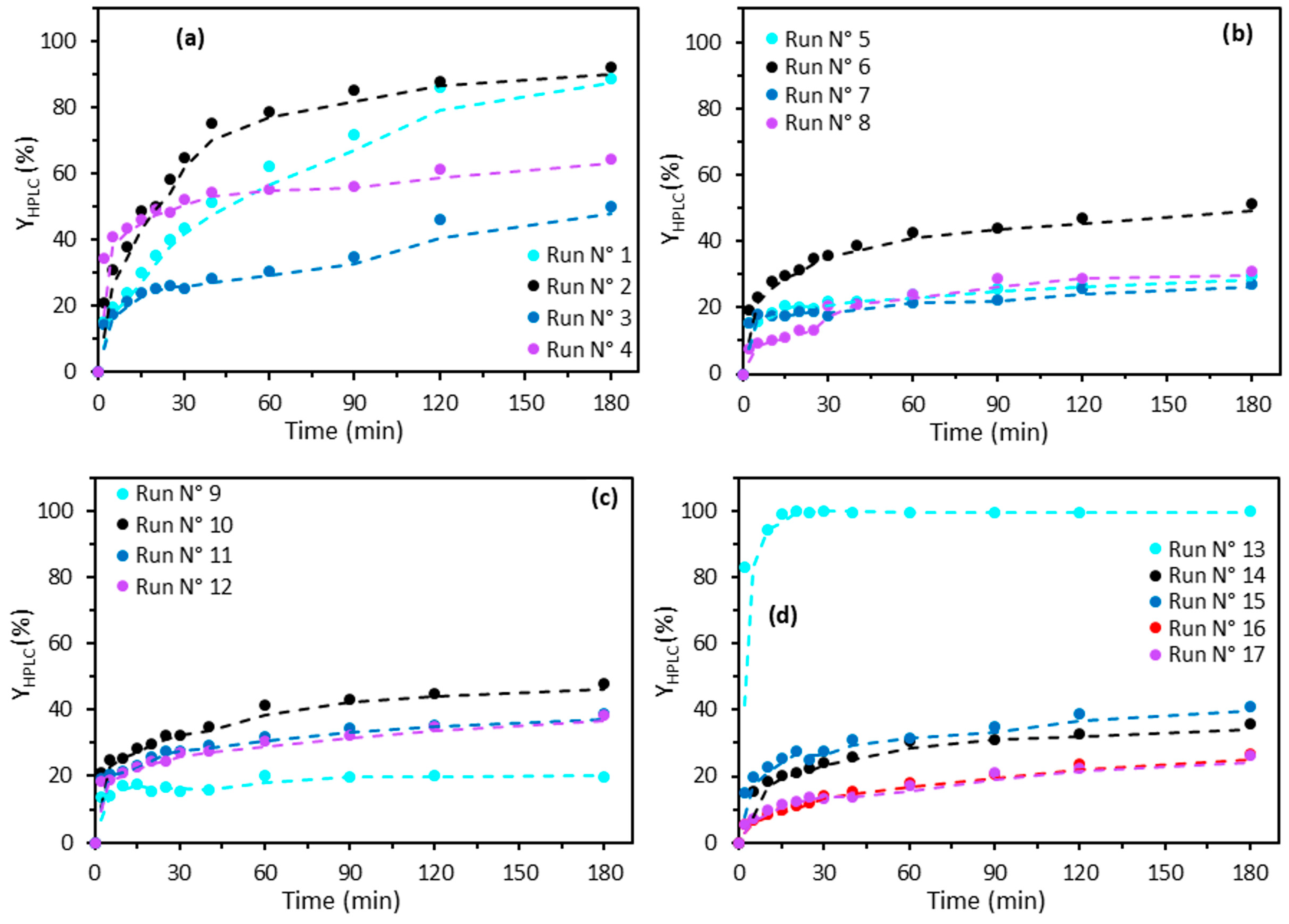
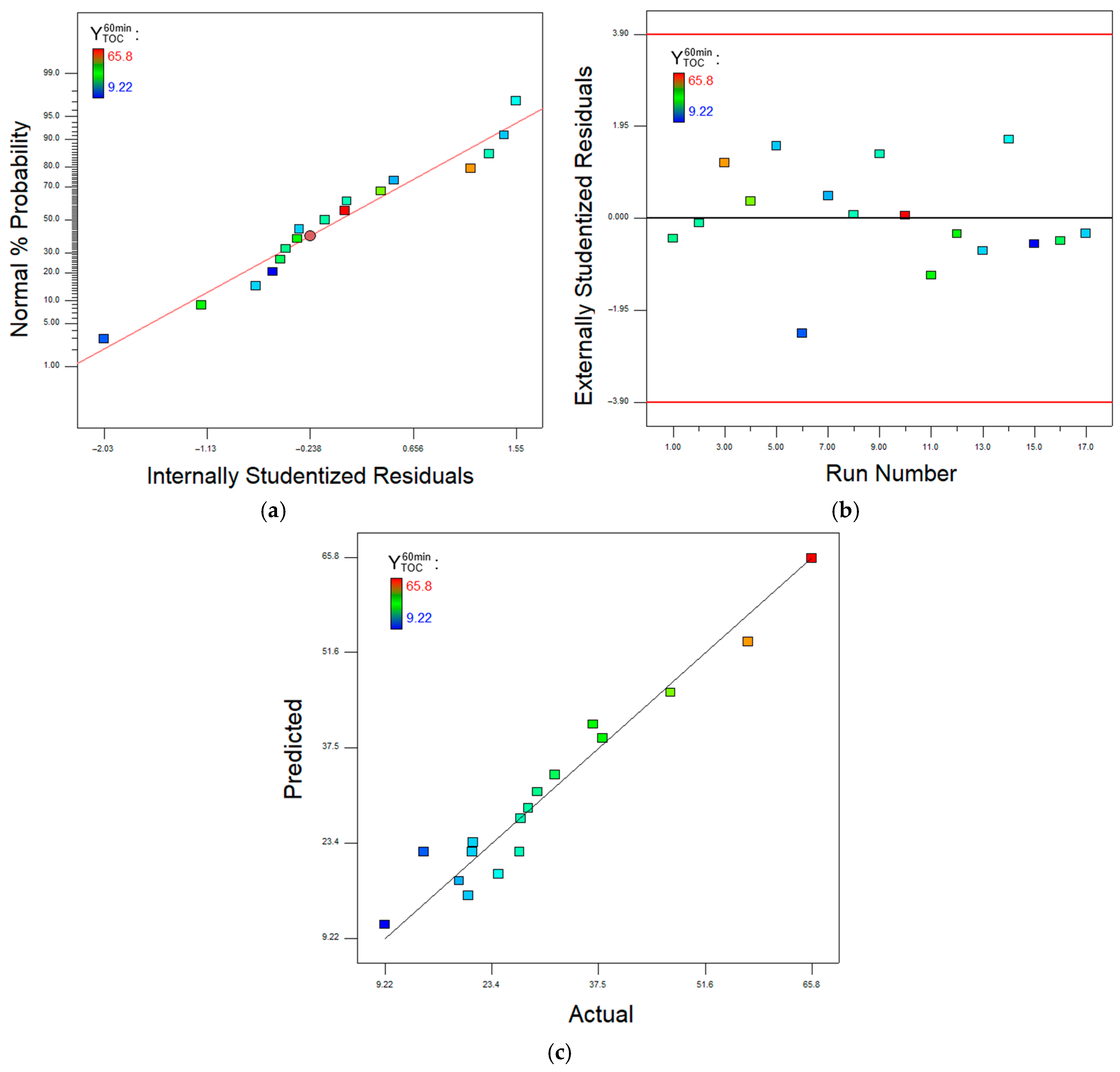
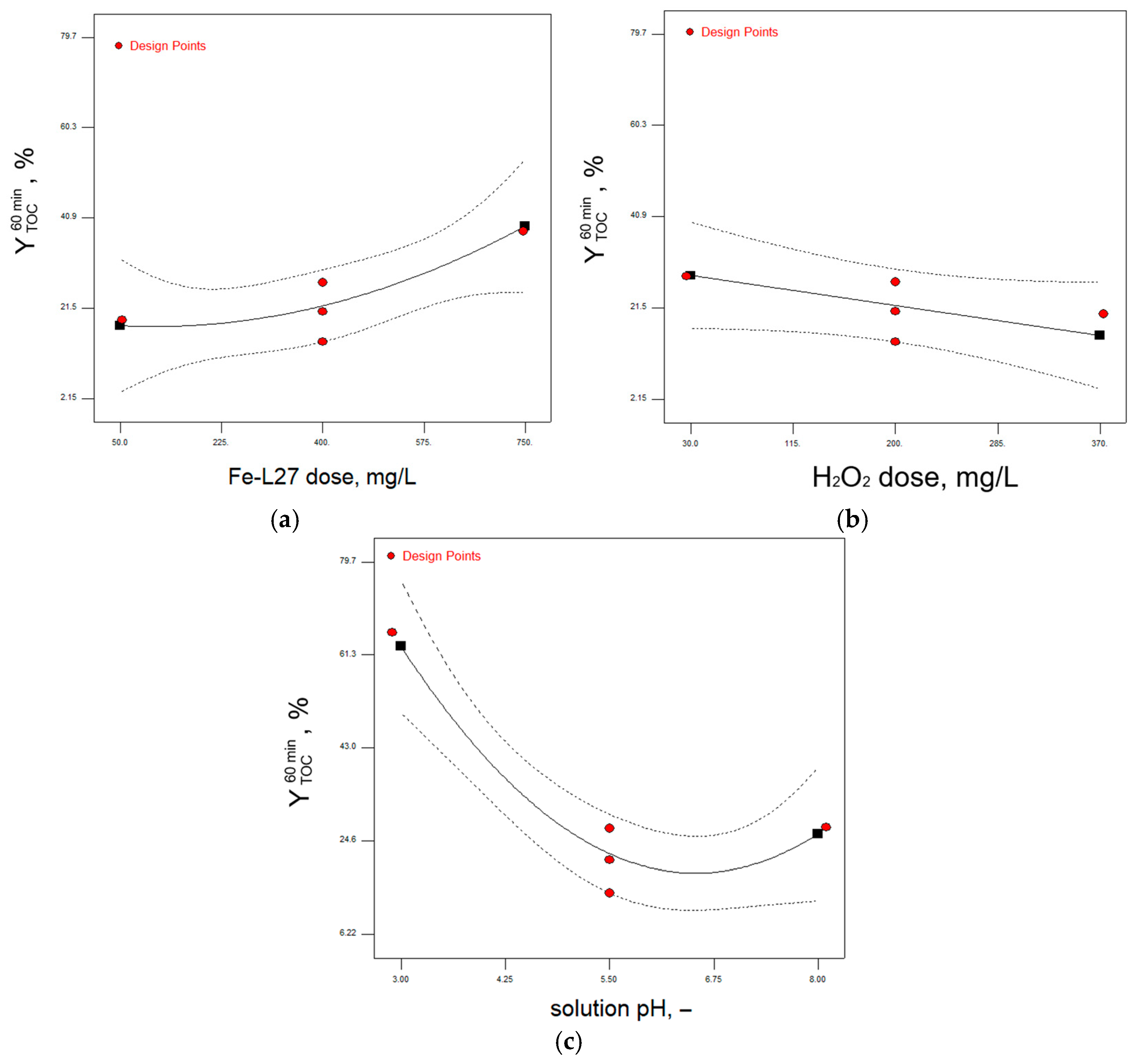
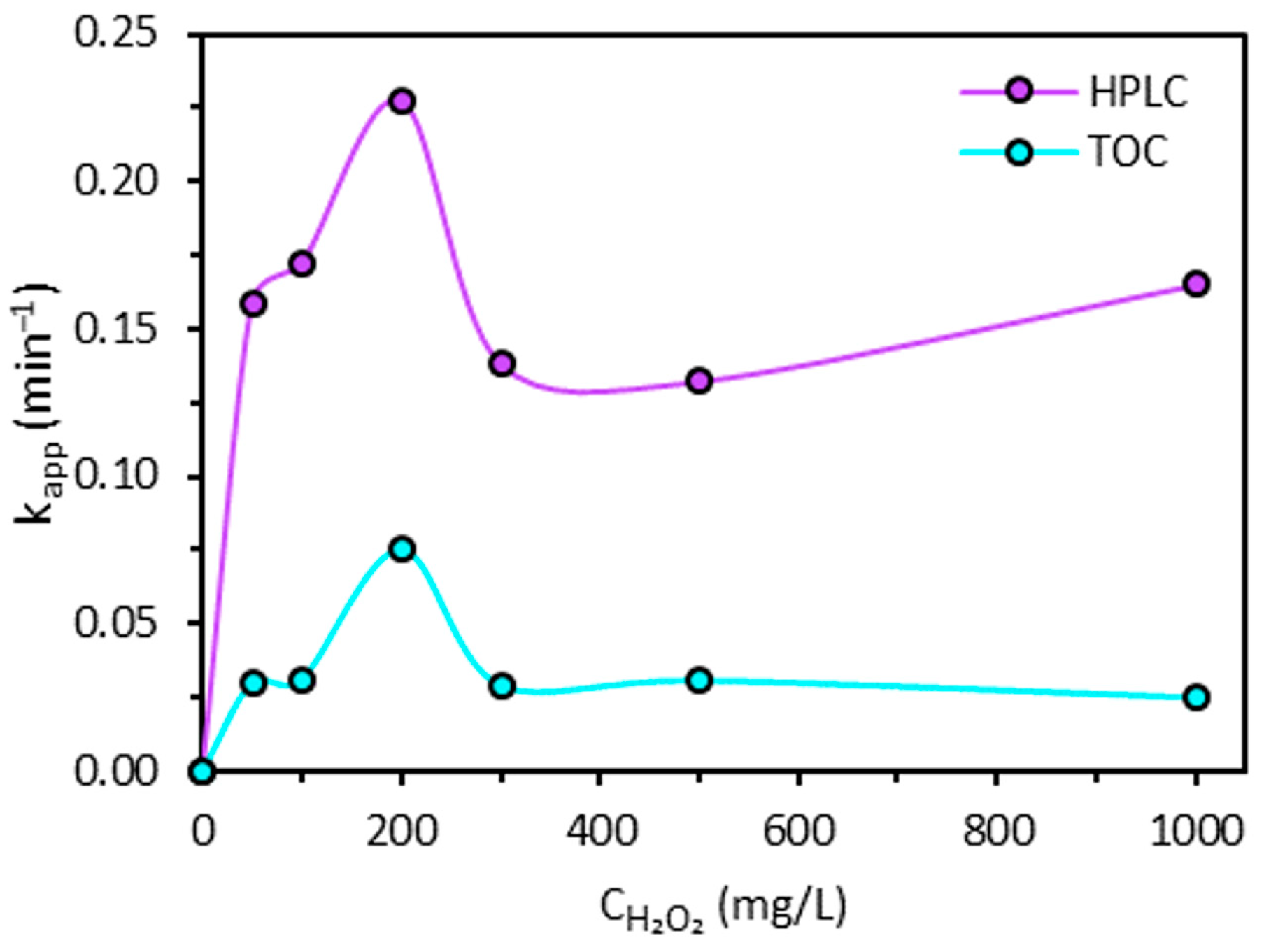
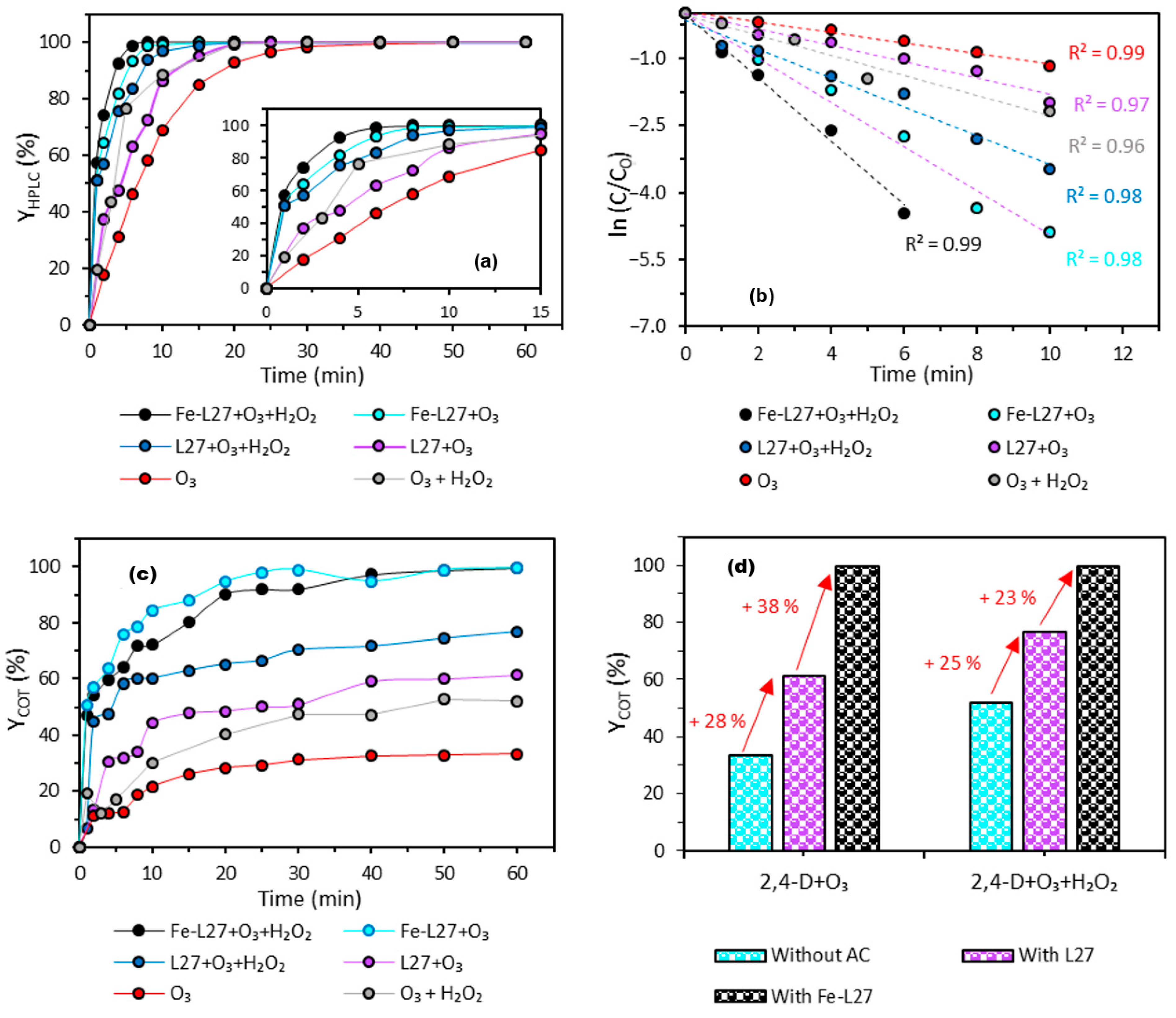

| Column | Restek Raptor C18 (100 mm × 3 mm × 2.7 μm) |
|---|---|
| Temperature (°C) | 40 |
| Mobile phase | A/B (65/35): A: water + acetic acid (90/10) B: acetonitrile |
| Analysis mode | Isocratic |
| Flow rate (mL min−1) | 0.8 |
| Pressure (bar) | 290 |
| Injection volume (μL) | 10 |
| Wavelength (nm) | 280 ± 4 |
| Retention time (min) | 1.6 |
| Source of Variation | Symbol | −α | Inferior Level | Intermediary Level | Superior Level | α |
|---|---|---|---|---|---|---|
| Fe-L27 dose, mg L−1 | z1 | 53.59 | 200 | 400 | 600 | 746.41 |
| H2O2 dose, mg L | z2 | 26.79 | 100 | 200 | 300 | 373.21 |
| Solution pH, − | z3 | 2.90 | 4.0 | 5.5 | 7.0 | 8.10 |
| Run No. | Input Variables | Responses | |||||||
|---|---|---|---|---|---|---|---|---|---|
| x1 | x2 | x3 | ,
% | ,
% | ,
% | ,
% | ,
% | ,
% | |
| 1 | −1 | −1 | −1 | 16 | 25 | 29 | 37 | 64 | 97 |
| 2 | 1 | −1 | −1 | 38 | 43 | 52 | 57 | 83 | 93 |
| 3 | −1 | 1 | −1 | 22 | 24 | 30 | 32 | 49 | 53 |
| 4 | 1 | 1 | −1 | 42 | 40 | 45 | 47 | 60 | 67 |
| 5 | −1 | −1 | 1 | 12 | 18 | 21 | 24 | 32 | 32 |
| 6 | 1 | −1 | 1 | 31 | 24 | 29 | 29 | 54 | 61 |
| 7 | −1 | 1 | 1 | 2 | 3 | 9 | 9 | 22 | 28 |
| 8 | 1 | 1 | 1 | 10 | 13 | 21 | 21 | 45 | 54 |
| 9 | −1.732 | 0 | 0 | 18 | 19 | 16 | 19 | 20 | 20 |
| 10 | 1.732 | 0 | 0 | 20 | 29 | 32 | 38 | 56 | 57 |
| 11 | 0 | −1.732 | 0 | 15 | 24 | 23 | 28 | 41 | 42 |
| 12 | 0 | 1.732 | 0 | 16 | 20 | 17 | 20 | 36 | 46 |
| 13 | 0 | 0 | −1.732 | 56 | 65 | 64 | 66 | 59 | 100 |
| 14 | 0 | 0 | 1.732 | 21 | 23 | 29 | 27 | 35 | 44 |
| 15 | 0 | 0 | 0 | 10 | 26 | 30 | 27 | 44 | 48 |
| 16 | 0 | 0 | 0 | 15 | 20 | 20 | 21 | 21 | 18 |
| 17 | 0 | 0 | 0 | 9 | 12 | 15 | 14 | 18 | 17 |
| Source | Sum of Square; Degrees of Freedom; F-Value; p-Value × 102 | ||||
|---|---|---|---|---|---|
| , % | , % | , % | , % | , % | |
| Model | 2700; 9; 6.59; 1.06 ** | 2810; 9; 6.66; 1.03 ** | 6870; 9; 7.22; 0.81 * | 3020; 9; 15.3; 0.08 * | 3410; 9; 20.6; 0.31 * |
| x1 | 398; 1; 8.72; 2.13 ** | 328; 1; 7.00; 3.32 ** | 826; 1; 7.81; 2.67 ** | 536; 1; 24.5; 1.66 ** | 522; 1; 28.5; 0.11 * |
| x2 | 24,9; 1; 0.55; 48.4 | 102; 1; 2.18; 18.4 | 126; 1; 1.19; 31.2 | 95.5; 1; 4.36; 7.51 *** | 198; 1; 10.8; 1.34 ** |
| x3 | 1080; 1; 23.6; 0.18 * | 1560; 1; 33.2; 0.07 * | 3240; 1; 30.7; 0.09 * | 1320; 1; 60.4; 0.01 * | 1730; 1; 94.3; <0.01 * |
| x1x2 | 17.3; 1; 0.38; 55.7 | 0.22; 1; 0.005; 94.7 | 1.14; 1; 0.01; 92 | 2.74; 1; 0.13; 73.4 | 0.24; 1; 0.01; 91.2 |
| x1x3 | 32.6; 1; 0.71; 42.6 | 34; 1; 0.726; 42.2 | 65; 1; 0.61; 45.9 | 44.4; 1; 2.03; 19.7 | 45.7; 1; 2.49; 15.9 |
| x2x3 | 216; 1; 4.74; 6.58 | 61.4; 1; 1.31; 29 | 50.7; 1; 0.48; 51.1 | 27.4; 1; 1.25; 30 | 8.34; 1; 0.46; 52.2 |
| x12 | 49.2; 1; 1.08; 33.4 | 2.25; 1; 0.05; 83.3 | 44.3; 1; 0.42; 53.8 | 5.34; 1; 0.24; 63.7 | 70.9; 1; 3.86; 9.01 |
| x22 | 13.3; 1; 0.29; 60.6 | 0.92; 1; 0.02; 89.3 | 84.6; 1; 0.8; 40.1 | 4.97; 1; 0.23; 64.8 | 11.7; 1; 0.64; 45.1 |
| x32 | 894; 1; 19.6; 0.31 * | 614; 1; 13.1; 0.85 * | 2440; 1; 23; 0.2 * | 818; 1; 37.4; 0.05 * | 861; 1; 46.9; 0.02 * |
| Residual | 319; 7 | 328; 7 | 741; 7 | 153; 7 | 129; 7 |
| Lack of Fit | 302; 5; 6.9; 13.1 | 226; 5; 0.89; 60.6 | 612; 5; 1.9; 38 | 45.6; 5; 0.17; 95.2 | 47.8; 5; 0.24; 91.6 |
| Pure Error | 17.5; 2 | 102; 2 | 129; 2 | 108; 2 | 80.7; 2 |
| Source | Sum of Square; Degrees of Freedom; F-Value; p-Value × 102 | ||||
|---|---|---|---|---|---|
| , % | , % | , % | , % | , % | |
| Model | 2600; 5; 13.6; 0.02 * | 2610; 3; 21.3; <0.01 * | 6530; 3; 26,1; <0.01 * | 2930; 4; 36.1; <0.01 * | 3340; 5; 37.8; <0.01 * |
| x1 | 398; 1; 10.4; 0.81 * | 328; 1; 8.04; 1.14 ** | 826; 1; 9.92; 0.77 * | 536; 1; 26.5; 0.02 * | 522; 1; 29.5; 0.02 * |
| x2 | 24,9; 1; 0.65; 43.6 | 95.5; 1; 4.72; 5.06 *** | 198; 1; 10.8; 0.65 ** | ||
| x3 | 1080; 1; 28.2; 0.02 * | 1560; 1; 38.1; <0.01 * | 3250; 1; 39; <0.01 * | 1320; 1; 65.3; 0.01 * | 1730; 1; 94.3; <0.01 * |
| x1x2 | |||||
| x1x3 | |||||
| x2x3 | 216; 1; 5.66; 3.65 *** | ||||
| x12 | 70.9; 1; 3.38; 9.32 | ||||
| x22 | |||||
| x32 | 885; 1; 23.1; 0.05 * | 721; 1; 17.7; 0.1 * | 2460; 1; 29.5; 0.01 * | 970; 1; 47.9; <0.01 * | 861; 1; 50.3; <0.01 * |
| Residual | 421; 11 | 530; 13 | 1080; 13 | 243; 12 | 194; 11 |
| Lack of Fit | 403; 9; 5.12; 17.4 | 428; 11; 0.76; 69.1 | 954; 11; 1.35; 50.2 | 135; 5; 13.5; 25.1 | 114; 9; 0.31; 91 |
| Pure Error | 17.5; 2 | 102; 2 | 129; 2 | 108; 2 | 80.7; 2 |
| Response | , % | , % | , % | , % | , % |
| R2 Radj2 Rpred2 Adequate precision Lack of fit F-tab Model F-tab | 0.861 0.798 0.665 14 19.38 3.2 | 0.831 0.792 0.676 15.4 19.4 3.41 | 0.858 0.825 0.62 17.8 19.4 3.41 | 0.923 0.898 0.873 21.4 19.3 3.26 | 0.945 0.92 0.896 21.8 19.38 3.2 |
| Objective | Criteria | Parameters | Response | Desirability | |||
|---|---|---|---|---|---|---|---|
| Fe-L27 Dose, | H2O2 Dose, | Solution pH, | |||||
| mg/L | mg/L | − | % | ||||
| 1 | max | x1, x2 and x3 in range | 730 | 224 | 2.98 | 78.5 | 1.0 |
| 2 | x1, x2 in range, x3 = 0 | 746 | 26.8 | 5.5 | 45.4 | 0.8 | |
| 3 | x1, x2 in range, x3 = 1.732 | 746 | 26.8 | 8.1 | 49.3 | 0.842 | |
| (%) | (%) | (%) | (%) | kapp (min−1) | |
| O3 | 69 | 22 | 100 | 33 | 0.12 |
| O3 + H2O2 | 89 | 30 | 100 | 52 | 0.23 |
| L27 + O3 | 86 | 44 | 100 | 61 | 0.18 |
| L27 + O3 + H2O2 | 97 | 63 | 100 | 77 | 0.31 |
| Fe-L27 + O3 | 99 | 84 | 100 | 100 | 0.49 |
| Fe-L27 + O3 + H2O2 | 100 | 72 | 100 | 100 | 0.71 |
Disclaimer/Publisher’s Note: The statements, opinions and data contained in all publications are solely those of the individual author(s) and contributor(s) and not of MDPI and/or the editor(s). MDPI and/or the editor(s) disclaim responsibility for any injury to people or property resulting from any ideas, methods, instructions or products referred to in the content. |
© 2025 by the authors. Licensee MDPI, Basel, Switzerland. This article is an open access article distributed under the terms and conditions of the Creative Commons Attribution (CC BY) license (https://creativecommons.org/licenses/by/4.0/).
Share and Cite
Samba, P.F.; Secula, M.S.; Schaefer, S.; Cagnon, B. Optimization of Organic Content Removal from Aqueous Solutions by Fenton-Ozonation. Appl. Sci. 2025, 15, 7370. https://doi.org/10.3390/app15137370
Samba PF, Secula MS, Schaefer S, Cagnon B. Optimization of Organic Content Removal from Aqueous Solutions by Fenton-Ozonation. Applied Sciences. 2025; 15(13):7370. https://doi.org/10.3390/app15137370
Chicago/Turabian StyleSamba, Paixan Febrialy, Marius Sebastian Secula, Sebastien Schaefer, and Benoît Cagnon. 2025. "Optimization of Organic Content Removal from Aqueous Solutions by Fenton-Ozonation" Applied Sciences 15, no. 13: 7370. https://doi.org/10.3390/app15137370
APA StyleSamba, P. F., Secula, M. S., Schaefer, S., & Cagnon, B. (2025). Optimization of Organic Content Removal from Aqueous Solutions by Fenton-Ozonation. Applied Sciences, 15(13), 7370. https://doi.org/10.3390/app15137370









